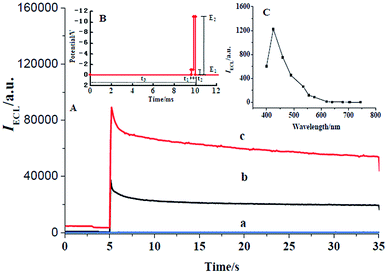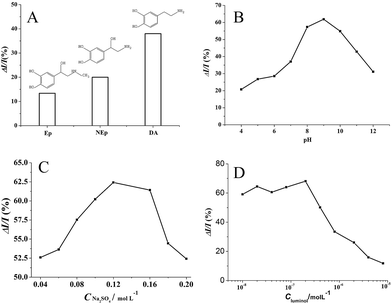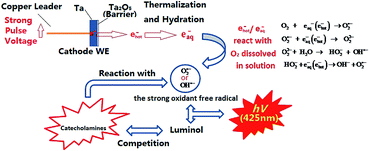Determination of ultra-trace catecholamines based on hot electron-induced cathodic electrochemiluminescence at a naturally oxide-covered tantalum electrode
Xiao-Yan Chenab,
Rui-Juan Zhengac,
Ling-Qing Rena and
Jian-Jun Sun*a
aKey Laboratory of Analysis and Detection for Food Safety, Ministry of Education, Fujian Provincial Key Laboratory of Analysis & Detection Technology for Food Safety, College of Chemistry, Fuzhou University, Fuzhou, 350108, China. E-mail: JJSun@fzu.edu.cn; Fax: +86-591-22866136; Tel: +86-591-22866136
bFujian Metrology Institute, Fuzhou, 350003, China
cDepartment of Chemistry and Materials Engineering, Longyan University, Longyan, Fujian 364000, China
First published on 29th January 2016
Abstract
Naturally oxide-covered tantalum electrodes (Ta/Ta2O5) are first used in the determination of ultra-trace catecholamines based on hot electron-induced cathodic electrochemiluminescence. Under natural conditions, an oxide film can be formed on the surface of tantalum electrode, at which the quenching effect of catecholamines on the hot electron-induced cathodic electrochemiluminescence (cathodic ECL) of luminol is found. Based on this quenching effect, detection of ultra-trace catecholamines is established. No previous anthropogenic modification of the electrode and no derivatization of the catecholamines are required before determination. Under the optimum conditions, the quench ratio is linearly increased with the logarithm of the concentration of epinephrine, dopamine and norepinephrine in the range of 2.0 × 10−8 mol L−1 to 2.0 × 10−6 mol L−1, 8.0 × 10−9 mol L−1 to 4.0 × 10−7 mol L−1 and 8.0 × 10−9 mol L−1 to 8.0 × 10−7 mol L−1 with the limit of detection (LOD) of 5.5 × 10−9 mol L−1 to 7.8 × 10−10 mol L−1 and 8.2 × 10−10 mol L−1, respectively.
Introduction
Epinephrine (Ep), norepinephrine (NEp) and dopamine (DA) are a group of biogenic amines possessing a catechol ring, and the name catecholamine (CA) was given to these substances. CAs play an important role in neurotransmission1 and other physiological processes.2,3 Higher-than-standard levels of CA will affect the cardiovascular system, lead to high blood pressure and myocardial infarction, and lower levels of CA will result in low blood pressure.Due to its important significance on scientific and medical applications, various methods4–19 for quantification of CA have been described earlier. In the light of the versatility and high sensitivity of mass spectrometry (MS), gas chromatography (GC),4–6 high performance liquid chromatography (HPLC)7–10 and capillary electrophoresis (CE)11–13 coupled with MS were used for the identification and quantitation of CAs in diverse samples. 1.4 × 10−10 mol L−1 and 1.5 × 10−10 mol L−1 of the detection limits of Ep and NEp were obtained respectively by HPLC-MS/MS.10 The main drawback of the GC/MS method remains in the need for sample derivatization, which is necessary to convert an analyte into a more volatile compound suitable for the analysis.14 And also, MS is high-end analytical instrument. So a variety of other sensitive detection methods are identified as the method of choice for the low cost of analysis, such as native laser-induced fluorescence detection (LIF),15 chemiluminescence (CL),16 electrochemistry (EC)17,18 and electrogenerated chemiluminescence (ECL).19 By these methods, the LOD of CAs could almost down to nanomolar. ECL has been paid considerable for CAs because of its simplified optical setup, good temporal and high selectivity. Zhihui Guo developed ECL method to determine DA and Ep at carbon nanotube/Nafion-ru(bpy)32+ composite film modified glassy carbon electrode. Although the method is sensitivity,19 the modification of the electrode possess complicated.
Compared with common electrogenerated chemiluminescence, hot electron-induced cathodic electrochemiluminescence (cathodic ECL) is of higher sensitivity. Since 1977, Kankare introduced cathodic ECL at oxide-covered tantalum electrode.20 Bard et al. developed the theory and the improvement of ECL has attribute to the injection of hot electrons into MeCN solution or aqueous solution by means of a Ta/Ta2O5 electrode.20–22 And the reports about the Ta/Ta2O5 electrode are mainly focused on the theory; it has not been applied to analytical techniques. In this work, naturally oxide-covered tantalum electrodes (Ta/Ta2O5) are firstly used in the determination of ultra-trace catecholamines based on the quenching effect of hot electron-induced cathodic electrochemiluminescence. By using this technique, we implement the indirect determination of nano-molar catecholamines for their various degrees quenching effect on the cathodic ECL of the luminol. Typically, it is applied to analysis adrenaline in epinephrine hydrochloride injection; the satisfied mean recoveries of 93.2–100.3% and the RSDs of 1.5–4.7% were obtained. The LOD of Ep would reach at the nmol level, while NEp and DA is lower than other methods. The results were shown in Table 1.
| Method | Catecholamines | LOD | Reference |
|---|---|---|---|
| a DPV is the abbreviation of differential pulse voltametry. | |||
| Quenching effect on cathodic ECL | Ep | 5.5 × 10−9 mol L−1 | This work |
| NEp | 8.2 × 10−10 mol L−1 | ||
| DA | 7.8 × 10−10 mol L−1 | ||
| UPLC-MS/MS | Ep | 1.4 × 10−10 mol L−1 | 10 |
| NEp | 1.5 × 10−10 mol L−1 | ||
| CE-LIF | Ep | 2.0 × 10−8 mol L−1 | 15 |
| NEp | 5.0 × 10−8 mol L−1 | ||
| DA | 3.0 × 10−8 mol L−1 | ||
| CE-CL | Ep | 9.3 × 10−9 mol L−1 | 16 |
| DA | 2.3 × 10−8 mol L−1 | ||
| DPVa at MnO2/Nafion/GCE | Ep | 5 × 10−9 mol L−1 | 17 |
| The enzyme-modified pre-reactor | Ep | 4.40 × 10−10 mol L−1 | 18 |
| DA | 1.08 × 10−10 mol L−1 | ||
| Electrogenerated chemiluminescence | Ep | 2 × 10−8 mol L−1 | 19 |
| DA | 6 × 10−10 mol L−1 | ||
Experimental
Chemicals and materials
The tantalum foil (99.99%, Beijing Mountain Technical development center for non-ferrous metals) electrodes had geometric areas of 1.0 cm2.Ep, NEp and DA were purchased from Fluka Chemie AG (Buchs, Switzerland), and luminol was purchased from J&K Scientific Company (Beijing, China). All other reagents were of analytical-grade, purchased from Shanghai Sinopharm Chemical Reagent Co. Ltd. China, and used without further purification. Milli-Q (Millipore, Bedford, USA) ultrapure water was used in all experiments. Hydrochloride injection was purchased from local hospital.
Stock solutions containing 1.0 × 10−3 mol L−1 luminol was prepared in Milli-Q water, and stored in the refrigerator at 4 °C.
Apparatus and measurements
A model VMP3 multichannel potentiostats (VMP3, Princeton Applied Research Co., Ltd., USA) was used as pulse generator. The counter electrode was a platinum foil (area ca. 4.0 cm2), while an Ag/AgCl (saturated KCl) electrode was a reference. The cathodic pulse parameters of the differential pulse amperometry (DPA) are fixed unless specially mentioned, with prepulse height of −1.0 mV (vs. Ag/AgCl), prepulse width of 0.2 ms, pulse potential of −11.0 V (vs. Ag/AgCl), pulse width of 0.2 ms, and pulse period of 10 ms for 30 s. The ECL signal was recorded by an Ultra-weak Chemiluminescence Analyzer (BPCL-K, Institute of Biophysics, Academia Silica, Beijing, China). The time for collecting ECL signals was 30 s, PMT was operated at −900 V, and the PMT window was opened towards the working electrode only. ECL spectrum was obtained by a series of optical filters and was rectified to a fluorometer using a tungsten lamp.Electrode preparation
The copper conductor was bond to the tantalum foil (area ca. 1.0 cm2) by Ag filled conductive adhesive, and the glued surface was sealed completely by superpower adhesive AB for 24 hours; the other surface of the Ta foil was smoothed gently on chamois leather with alumina powder (P < 0.05 μm), then ultrasonic cleaned in the ethanol solution and the de-ionized water respectively. Finally, the resulting Ta foil was exposed and oxidized naturally in the air for 24 hours to obtain the Ta/Ta2O5 electrode.Results and discussion
Dependence of cathodic ECL on the oxide film covered on the tantalum electrode
To investigate the dependence of Intensity of cathodic ECL (IECL) on the oxide film covered on the tantalum electrode, the naturally oxide-covered tantalum electrode and the tantalum electrode (Ta) were used for cathodic ECL of 0.01 mM luminol respectively. As shown in Fig. 1, lower IECL of the luminol is detected at tantalum electrode during cathodic pulse polarization (Fig. 1A(a)), while strong intensity (Fig. 1A(c)) and low background emission (Fig. 1A(b)) are observed at the naturally oxide-covered tantalum electrode. It's indicated that the ECL intensity of luminol was enhanced dramatically during the cathodic pulse potential of −11.0 V due to the oxide film covered on the tantalum electrode.As expounded by Sung,21 when the Ta electrode exposed in air, about 2.5 nm thick native oxide films would be formed on the surface, which is essential for cathodic ECL. Under cathodic pulse polarization, the electrons are emitted and tunnelled through the oxide film into the conduction band of water. They gain energy from the insulating film, and become the hot electrodes (ehot). Some of ehot turn into hydrated electrons (eaq) after thermalization and hydration,23,24 and interacted with O2 dissolved in solution forming the strong oxidant free radical O2˙− and OH25,26 (as shown in Fig. 5). Hence, luminol and the free radicals are simultaneously achieved in the vicinity of the electrode surface, and cathodic ECL of luminol occurred (λ = 425 nm). The eaq would be regarded as an electron that was orderly surrounded by water molecules. It owns stronger reduction than other electrode; its onset pulse is close to the conduction band edge of water23 (E° = − 2.9 V vs. SCE).
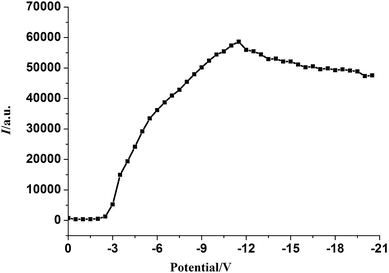 | ||
| Fig. 2 Influence of cathodic pulse potential. Other conditions are as in Fig. 1. | ||
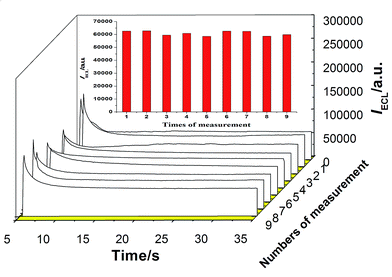 | ||
| Fig. 3 Stability of the naturally oxide-covered tantalum electrode. 0.01 mM luminol in the 0.2 M borate buffer solution (pH 9.0) containing 0.1 M Na2SO4. The cathodic pulse parameters of DPA are as Fig. 1B for 30 s. | ||
As shown in Fig. 2, the cathodic onset pulse potential of this system is in accordance with the conduction band edge of water (E° = − 2.9 V vs. SCE). It is indicated that the existence and importance of the hydrated electron. With the pulse potential increasing, the more electrons tunnelled through the insulating film, the more hot electrodes engender with absorption of the energy. When the pulse potential is higher than −11.0 V, the process of generating hydrated electrons tended to be stabilized. To deliberate on all of this, −11.0 V was selected as the optimal cathodic pulse potential.
Under the optimized cathodic pulse potential selected above, the cathodic ECL spectrum of the luminol at the naturally oxide-covered tantalum electrode in Fig. 1C reveals that its emission maxima at about 425 nm, in accordance with traditional ECL spectrum of luminol. It's indicated that 3-aminophthalic acid radical ion is still the luminescent substance in the system, and the mechanism of ECL of luminol is unchanged by cathodic pulse polarization, while the intensity is much stronger.
Stability of cathodic ECL at the naturally oxide-covered tantalum electrode
The reproducibility of the ECL at the oxide-covered tantalum electrode was shown in Fig. 3. The 9 parallel determinations of luminol at a concentration of 1.0 × 10−5 mol L−1 gave a RSD of 2.9%. The stability and repeatability of the oxide-covered tantalum electrode are basically satisfactory; this electrode is in the advantages of low cost, ease of fabrication, and good stability and reproducibility, so it could be applied to analytical techniques.Quenching effect of catecholamines
Quenching effects of Ep, NEp and DA on the cathodic ECL were investigated and the results were shown in Fig. 4A. As known, catecholamines all have a catechol ring and the catechol ring would react with the strong oxidant free radical O2˙− or OH˙, forming quinoidal products. The possible mechanism was shown in Fig. 5. Ep, NEp and DA exhibited strong quenching effect of the cathodic ECL due to their excellent deoxidization ability.Optimization of determination of catecholamines
The effect of pH, the concentration of Na2SO4 and the concentration of luminol on the determination of Ep were investigated and the results were shown in Fig. 4B, C and D, respectively.As shown in Fig. 4B, the influence of pH on the ECL intensity was investigated in the range from pH 4.0 to pH 12.0. The cathodic ECL signals were weaken when pH is lower than 4.0 for the conjugate reaction of hydrated electrons; the quench ratio of Ep was most evident at pH 9.0. With the increased of pH value, the quenching effect decreased, it is probably because the catechol ring is easier to react with eaq in weak alkalic solution, so pH 9.0 was chosen.
As a supporting electrolyte, CNa2SO4 might affect the polarization current of electrode. Fig. 4C showed that the quenching efficiency of Ep (ΔI/I) increased with the increase of concentration of Na2SO4 (CNa2SO4) until CNa2SO4 got to the 0.12 mol L−1. Presumably, too much Na2SO4 added into buffer solution, the capacity of the reaction between luminol and the free radical enhanced, while competitive inhibition of ECL of Ep reduced. So 0.12 mol L−1 of CNa2SO4 was selected.
As shown in Fig. 4D, the quenching effect of Ep increased gradually with the increase of the concentration of luminol (Cluminol) until Cluminol reaches the 2.0 × 10−7 mol L−1, which might correlated with the concentration of the strong oxidant radical. When too much luminol added into buffer solution, the competition between catechol and luminol will be eliminated. And 2.0 × 10−7 mol L−1 was chosen as the optimal Cluminol.
Other conditions are as Fig. 1 (I and I′ were the intensity of cathodic ECL before and after adding catecholamines into 0.01 mM luminol solution, and ΔI = I − I′).
LOD and calibration linearity of determination of catecholamines
Under the optimal conditions of determination of Ep, the relationship between the quenching efficiency of the ECL intensity (ΔI/I) and the logarithm of the concentration of Ep, NEp and DA exhibited satisfactory linearity over the range of 2.0 × 10−8 mol L−1 to 2.0 × 10−6 mol L−1, 8.0 × 10−9 mol L−1 to 8.0 × 10−7 mol L−1 and 8.0 × 10−9 mol L−1 to 4.0 × 10−7 mol L−1 with the limit of detection of 5.5 × 10−9 mol L−1, 8.2 × 10−10 mol L−1 and 7.8 × 10−10 mol L−1, respectively. The results of regression analysis were shown in Table 2. The LOD of Ep, NEp and DA would reached at the nmol level, while is closed to the lowest LOD of the other methods shown in Table 2.| Analyte | Linear range (mol L−1) | Regressions equation (y = ax + b) | Correlation coefficient (R2) | Detection limits (mol L−1) |
|---|---|---|---|---|
| Ep | 2.0 × 10−8 to 2.0 × 10−6 | ΔI/I = 0.42 × log![[thin space (1/6-em)]](https://www.rsc.org/images/entities/char_2009.gif) C + 3.3 C + 3.3 |
0.997 | 5.5 × 10−9 |
| NEp | 8.0 × 10−9 to 8.0 × 10−7 | ΔI/I = 0.37 × log![[thin space (1/6-em)]](https://www.rsc.org/images/entities/char_2009.gif) C + 3.0 C + 3.0 |
0.997 | 8.2 × 10−10 |
| DA | 8.0 × 10−9 to 4.0 × 10−7 | ΔI/I = 0.40 × log![[thin space (1/6-em)]](https://www.rsc.org/images/entities/char_2009.gif) C + 3.3 C + 3.3 |
0.996 | 7.8 × 10−10 |
Recovery of adrenaline
As shown in Fig. 4, catecholamines exhibited strong quenching effect of the cathodic ECL at the oxide-covered tantalum electrode. So the method also can be used for determination of catecholamines. But at the same time, when the method used to determine the analyses coexisting with various other catecholamines, other catecholamines would affect the accuracy of the measurement of adrenaline.Applied to determine adrenaline in epinephrine hydrochloride injection, the proposed method is of high sensitivity. As shown in Table 3, the adrenaline in the epinephrine hydrochloride injection exhibited obvious quenching effect on the cathodic ECL, and the recovery was about 93.2% with RSD of 4.7%. Moreover, 0.200 μmol L−1 and 0.800 μmol L−1 of adrenaline were added into the injection respectively to investigate the recovery rate. As shown in Table 3, the mean recoveries of 93.2–100.3% and RSDs of 1.5–4.7% were obtained.
| Nominal concentration (μmol L−1) | Conc. detected with this method (μmol L−1) | Recovery (%) | RSD (%) | |
|---|---|---|---|---|
| Ep in the injection | 0.200 | 0.186 | 93.2 | 4.7 |
| After adding to the injection | 0.400 | 0.384 | 96.0 | 3.9 |
| 1.000 | 1.003 | 100.3 | 1.5 |
Conclusions
The hot electron-induced cathodic ECL at the naturally oxide-covered tantalum electrode was applied to the ultra-trace analytical technique. The signals of cathodic ECL were sensitive, stable and reproducible. The naturally oxide-covered tantalum electrode is an effective one to realize the determination of catecholamines at trace level. The mean recoveries of 93.2–100.3% and the RSDs of 1.5–4.7% were obtained in the determination of adrenaline in epinephrine hydrochloride injection, which were basically satisfactory for pharmaceutical analysis. No previous anthropogenic modification of the electrode and no derivatization of the catecholamines are required.Acknowledgements
The authors thank for the financial support from the National Science Foundation of China (No. 21275030, 21475023), The National Key Technologies R & D Program of China during the 12th Five-Year Plan Period (No. 2012BAD29B06).Notes and references
- C. Braestrup, M. Nielsen and J. Scheel-Kruger, J. Neurochem., 1974, 23, 569 CrossRef CAS PubMed.
- J. Bergquist and J. Silberring, Rapid Commun. Mass Spectrom., 1998, 12, 683 CrossRef CAS PubMed.
- U. Knigge, E. Willems, A. Kjaer, H. Jrgensen and J. Warberg, Endocrinology, 1999, 140, 3713 CAS.
- P. S. Doshi and D. J. Edwards, J. Chromatogr. A, 1979, 176, 359 CrossRef CAS PubMed.
- G. A. Smythe, G. Edwards, P. Graham and L. Lazarus, Clin. Chem., 1992, 38, 486 CAS.
- J. J. Willemsen, H. A. Ross, B. G. Wolthers, C. G. Sweep and I. P. Kema, Ann. Clin. Biochem., 2001, 38, 356 CrossRef CAS PubMed.
- V. Carrera, E. Sabater, E. Vilanova and M. A. Sogorb, J. Chromatogr. B, 2007, 847, 88 CrossRef CAS PubMed.
- F. Gosetti, E. Mazzucco, M. C. Gennaro and E. Marengo, Anal. Bioanal. Chem., 2013, 405, 907 CrossRef CAS PubMed.
- S. C. Wang, H. H. Shih, D. T. Rossi and W. Campbell, Microchem. J., 2007, 87, 163 CrossRef CAS.
- C. Ji, J. Walton, Y. Su and M. Tella, Anal. Chim. Acta, 2010, 670, 84 CrossRef CAS PubMed.
- K. Vuorensola, H. Sirén and R. Kostiainen, J. Chromatogr. A, 2002, 979, 179 CrossRef CAS PubMed.
- H. Sirén, T. Seppänen-Laakso and M. Oreši, J. Chromatogr. B, 2008, 871, 375 CrossRef PubMed.
- Z. D. Peterson, D. C. Collins, C. R. Bowerbank, M. L. Lee and S. W. Graves, J. Chromatogr. B, 2002, 776, 221 CrossRef CAS.
- J. Bergquist, A. Śclubisz, A. Kaczor and J. Silberring, J. Neurosci. Methods, 2002, 113, 1 CrossRef CAS PubMed.
- H. T. Chang and E. S. Yeung, Anal. Chem., 1995, 67, 1079 CrossRef CAS PubMed.
- Y. S. Zhao, S. L. Zhao, J. M. Huang and F. G. Ye, Talanta, 2011, 85, 2650 CrossRef CAS PubMed.
- X. J. Liu, D. X. Ye, L. Q. Luo, Y. P. Ding, Y. L. Wang and Y. L. Chu, J. Electroanal. Chem., 2012, 665, 1 CrossRef CAS.
- K. Hayashi, Y. Iwasaki, R. Kurita, K. Sunagawa, O. Niwa and A. Tate, J. Electroanal. Chem., 2005, 579, 215 CrossRef CAS.
- Z. H. Guo and S. J. Dong, Electroanalysis, 2004, 17, 607 CrossRef.
- J. J. Kankare, D. E. Ryan and B. J. Fürst, Can. J. Chem., 1977, 55, 1193 CrossRef CAS.
- Y. E. Sung, F. Gaillard and A. J. Bard, J. Phys. Chem. B, 1998, 102, 9797 CrossRef CAS.
- Y. E. Sung and A. J. Bard, J. Phys. Chem. B, 1998, 102, 9806 CrossRef CAS.
- M. Håkansson, Q. Jiang, M. Helin, M. Helin, M. Putkonen, A. J. Niskanen, S. Pahlberg, T. Ala-Kleme, L. Heikkila, J. Suomi and S. Kulmala, Electrochim. Acta, 2005, 51, 289 CrossRef.
- T. Ala-Kleme, S. Kulmala and M. Latva, Acta Chem. Scand., 1997, 51, 54 CrossRef.
- S. Kulmala, T. Ala-Kleme and A. Kulmala, Anal. Chem., 1998, 70, 1112 CrossRef CAS.
- S. Kulmala, T. A. Kleme and L. Vare, Anal. Chim. Acta, 1999, 398, 41 CrossRef CAS.
| This journal is © The Royal Society of Chemistry 2016 |

